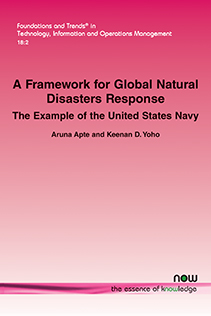A Framework for Global Natural Disasters Response: The Example of the United States Navy
By Aruna Apte, Professor of Humanitarian Logistics, Department of Defense Management, Naval Postgraduate School, USA, auapte@nps.edu | Keenan D. Yoho, Professor of Operations, Roy E. Crummer Graduate School of Business, Rollins College, USA, kyoho@rollins.edu
Abstract
Climate change is affecting the entire earth and due to increases in temperatures and greenhouse gases, we are starting to observe events that would not have existed several decades ago. The United Nations (UN) projects that the number of natural disasters will reach 560 a year by 2030. The UN report also says that “the scale and intensity of disasters are increasing, with more people killed or affected, in the last five years, than in the previous five.” The result of this is that those least able to protect themselves or to move out of the path of danger – particularly in developing countries – will be most at risk and will suffer disproportionately. All this leads to our motivation for a framework that will help these nations respond more effectively to natural disasters. The United States Navy (USN) is one organization capable of providing Humanitarian Assistance and Disaster Relief (HADR) on a global scale and its effectiveness has been illustrated in some of the largest natural disasters in the last twenty years. However, in the future, the demand for disaster response will likely outgrow the ability of the USN to respond effectively everywhere there is need. Therefore, it is useful for nations to learn about what has made the USN effective in responding to past disasters as well as what gaps remain in disaster response need.
This monograph introduces frameworks for humanitarian operations to respond to natural disasters worldwide in ways that are effective and efficient. We will illustrate the frameworks using the case of the United States Navy (USN). We will suggest ways in which Non-Government Organizations (NGO) can apply the lessons learned from previous disaster responses that consider capabilities, cost, and proximity of resources to the disaster location. However, we will point out that dependance on the USN for HADR may not be the best solution for countries in the Asia Pacific region. Given that the USN is moving towards retiring large deck ships and moving onto Next Generation Logistics Ships (NGLS), especially for the logistics support in contested environments, the humanitarian aid may not be easily available in the future. With this perspective in mind, we make some recommendations for what Southeast Asian countries can do to become self-sufficient in the domain of disaster response. We also propose addressing disaster response as a design problem and identifying the fundamental components for developing a design to more effectively confront disaster response challenges in the future.
A Framework for Global Natural Disasters Response: The Example of the United States Navy
A Framework for Global Natural Disasters Response introduces cases and frameworks that address global humanitarian logistics and disaster response conducted by the United States Navy (USN). The purpose of introducing these cases and frameworks is to identify those capabilities that enable efficient and effective responses to a humanitarian crisis or disaster. First, the monograph provides a motivation for the attention given to humanitarian assistance and disaster response by addressing climate change and the impact of natural disasters in the Asia Pacific region, which is the most heavily populated region on earth. Second, the authors identify metrics for determining operational readiness to respond to a disaster event. Third, the authors identify capabilities and competencies that have proven most effective among all those available to the United States Navy during a disaster response and draw upon several cases to illustrate the points empirically. Finally, the authors introduce a design perspective for considering the future of disaster response and focus on four design elements for building an effective disaster response: technology, organization, information, and policy.
